History and Overview
Early history
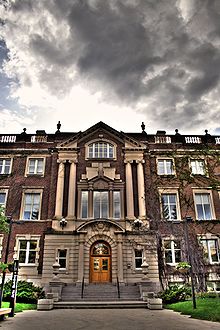
Convocation Hall, University of Alberta campus.
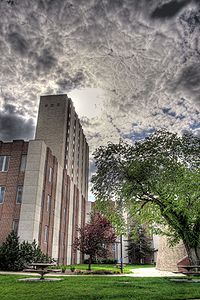
Tory building at the University of Alberta

Biology Building at the University of Alberta
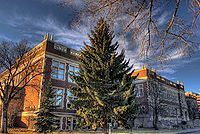
Corbett Hall, University of Alberta campus.
The University of Alberta, a single, public provincial university, was chartered in 1906 in Edmonton, Alberta with a new University Act. University of Alberta was modelled on the American state university, with an emphasis on extension work and applied research.
University of Alberta is a non-denominational university which offers undergraduate and graduate programs. With the hiring of Henry Marshall Tory in 1907, the University of Alberta started operation in 1908 using temporary facilities, while the first building on campus was under construction.
In a letter from Henry Marshall Tory to Alexander Cameron Rutherford in early 1906, while he is in the process of setting up McGill University College in Vancouver, Tory writes "If you take any steps in the direction of a working University and wish to avoid the mistakes of the past, mistakes which have fearfully handicapped other institutions, you should start on a teaching basis." The University of Alberta was established by the University Act, 1906 in the first session of the new Legislative Assembly, with Premier Alexander C. Rutherford as its sponsor.
The governance was modelled on Ontario's University of Toronto Act of 1906 which established a bicameral system of university government consisting of a senate (faculty), responsible for academic policy, and a board of governors (citizens) exercising exclusive control over financial policy and having formal authority in all other matters. The president, appointed by the board, was to provide a link between the 2 bodies and to perform institutional leadership.
It awarded its first degrees in 1912. In 1912 the university established its Department of Extension. In the early part of 20th century, professional education expanded beyond the traditional fields of theology, law and medicine. Graduate training based on the German-inspired American model of specialized course work and the completion of a research thesis was introduced. In 1929, the university established a School of Education. In 1932, the University Department of Extension established the Banff School of Finer Arts.
The policy of university education initiated in the 1960s responded to population pressure and the belief that higher education was a key to social justice and economic productivity for individuals and for society. In 1966, the University of Alberta introduced a masters program in community development.
The single-university policy in the West was changed as existing colleges of the provincial universities gained autonomy as universities - the University of Calgary was established in 1966. The University of Alberta first offered programs of study at Calgary in 1945 and continued until 1966 when the University of Calgary was established as an autonomous institution.
In 1976, structural engineer Reuben VandeKraats made the decision to add a more complex building style to the newly designed science and art wings of the school.
Location
The location of the university was to be decided along the same lines as that of Saskatchewan. (The province of Saskatchewan shares the same founding date as Alberta, 1905.) Saskatchewan had to please two competing cities when deciding the location of its capital city and provincial university. Thus, Regina was designated the provincial capital and Saskatoon received the provincial university, the University of Saskatchewan. The same heated wrangling over the location of the provincial capital also took place in Alberta between the cities of Calgary and Edmonton. It was stated that the capital would be north of the North Saskatchewan River and that the university would be in a city south of it. In the end the city of Edmonton became capital and the city just south of the river, Strathcona was granted the university, much to the chagrin of Calgary, for many years to come.
Meanwhile, in 1912 the two cities of Edmonton and Strathcona were amalgamated under the name of the former; Edmonton had thus became both the political and academic capital, at the expense of Calgary. This was just one act in a larger rivalry between the two cities, often called the Battle of Alberta.
In 1940, the University's Garneau neighbourhood was chosen as the location for the Garneau Theatre, in large part an effort to garner the University student's patronage.
Faculties
In 1913, a medical school established at the University of Alberta in Edmonton was opened. By 1920, the university had six faculties (Arts and Sciences, Applied Science, Agriculture, Medicine, Dentistry, and Law) and two schools (Pharmacy and Accountancy). It awarded a range of degrees: Bachelor of Arts (BA), Bachelor of Science (BSc), Bachelor of Science in Agriculture (BSA), Bachelor of Laws (LLB), Bachelor of Pharmacy (PhmB), Bachelor of Divinity (BD), Master of Arts (MA), Master of Science (MSc), and Doctor of Laws (LLD). There were 851 male students and 251 female students, and 171 academic staff, including 14 women.
Newspapers
The university has two main newspapers, Folio and The Gateway. Folio is the official newspaper published by the "Office of Public Affairs" every two weeks from September to June. The Gateway is the official student newspaper. Fully autonomous, it publishes "most Tuesdays and Thursdays".
The university also has the independent newspaper The Gold Standard and a monthly student newspaper, the Dagligtale, published at Augustana Campus in Camrose, Alberta.
Radio
In 1927, the university established the CKUA Educational radio station.
Book publishing
The University of Alberta Press, which was founded in 1969, concentrates on western Canadian history, general science and ecology. The University of Alberta Press publishes an average of between 20 and 30 books per year, often accepting submissions from across Canada for over 50% of the publications. Their current active title listing has more than 150 books, as of 2007.
学术
Profile
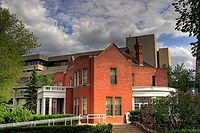
Rutherford House, located on the north-east corner of the University of Alberta campus.
As of 2008, the U of A had approximately 36,000 students, including 6,600 graduate students and 2,700 international students representing 128 countries. The university has 3,506 academic staff along with about 10,640 support and trust staff. University professors have won more 3M Teaching Fellowships (Canada's top award for undergraduate teaching excellence) than any other Canadian university, 30 awards since 1986. The university offers post-secondary education in about 200 undergraduate and 170 graduate programs. Tuition and fees for both fall and winter semesters are slightly more than $5,000 for a typical undergraduate student, although they vary widely by program. The University of Alberta switched from a 9-point grading scale to the more common 4-point grading scale in September 2003. 67 Rhodes Scholars have come from the University of Alberta.
Faculties and colleges
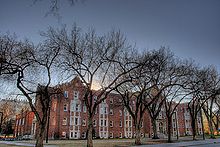
St. Joseph’s College at the University of Alberta
See also: Faculties and departments of the University of Alberta
The university has eighteen faculties and two affiliated colleges.
- Faculty of Agricultural, Life and Environmental Sciences focuses on natural, biological, and human resources. The University of Alberta Faculty of Forestry is part of the AUFSC and has accredited baccalaureate of science programs.
- Bachelor of Science in Agriculture - Pre-Veterinary Medicine Program; Bachelor of Science in Agriculture with Major in Agricultural and Resource Economics; Bachelor of Science in Agriculture with Major in Animal Science; Bachelor of Science in Agriculture with Major in Crop Science; Bachelor of Science in Agriculture with Major in Range and Pasture Management; Bachelor of Science in Agriculture with Major in Sustainable Agricultural Systems
- Master of Agriculture in Agricultural, Food and Nutritional Science; Master of Agriculture in Agroforestry; Master of Agriculture in Forest Economics; Master of Agriculture in Rural Sociology; Master of Agriculture in Soil Science; Master of Agriculture in Water and Land Resources; Master of Business Administration / Master of Agriculture
- Faculty of Agriculture, Forestry & Home Economics: Dept. of Agricultural, Food & Nutritional Science has an accredited dietetic program. The university is accredited by a professional organization such as the Dietitians of Canada and the university's graduates may subsequently become registered dietitians. List of universities with accredited dietetic programs
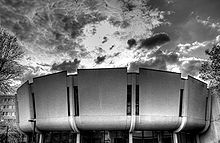
The Lecture Theaters section of the Humanities Center.
- Faculty of Arts is home to the spectrum of Arts programs and departments, from Anthropology to Women's Studies.
- Augustana 教职员工 is located in a satellite campus in Camrose, Alberta. It comprises the departments of Fine Arts, Humanities, Physical Education, Science, and Social Sciences.
- School of Business offers MBA, BCom, PhD, ExecEd, and Exec MBA degrees.
- Faculty of Education offers undergraduate and graduate degrees in Elementary, Secondary Education, or combined.
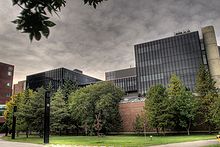
The Mechanical Engineering Building.
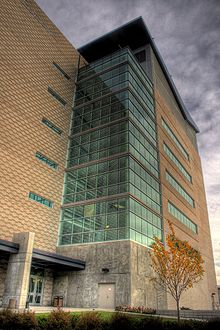
The Natural Resources Engineering Facility.
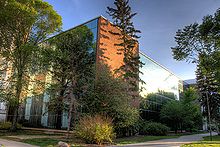
The Earth Sciences building.
- Faculty of Engineering offers undergraduate degrees in four engineering departments. Students can choose to specialize in the following disciplines: Physics Materials Engineering, Mining Engineering, Petroleum Engineering, Chemical Engineering, Computer Engineering, Civil Engineering, Electrical Engineering and Mechanical Engineering.
- Faculty of Extension is focusing on the life-long Continuing Education and Professional Development.
- Campus Saint-Jean is a Francophone faculty with programs in Sciences, Fine Arts and Languages, Social Sciences, and Education.
- Faculty of Graduate Studies and Research maintains graduate studies.
- Faculty of Law
- Faculty of Medicine and Dentistry
- Faculty of Native Studies
- Faculty of Nursing
- Faculty of Pharmacy and Pharmaceutical Sciences
- Faculty of Physical Education and Recreation focuses on the studies of human movement through sport science, kinesiology, physical education, physical activity and health, and tourism studies. The Faculty of Physical Education offers undergraduate programs in Bachelor of Arts in Recreation and Sport Tourism, Bachelor of Physical Education,Bachelor of Physical Education/Education (5-year combined degree offered in conjunction with the Faculty of Education), and Bachelor of Science in Kinesiology.
- School of Public Health
- Faculty of Rehabilitation Medicine
- Faculty of Science
- St. Joseph's College
- St. Stephen's College
Library system
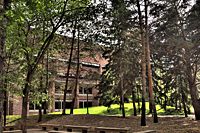
The Rutherford Humanities and Social Sciences Library
The University of Alberta library system [2], received a tremendous boost with the opening of the Rutherford Library in May 1951, and now has one of the largest research libraries systems in Canada. As of 2004, according to the Association of Research Libraries, the library system is the second-largest, by the number of volumes held, among all Canadian universities, after the University of Toronto Library. In 2006, the university library was rated 20th in North America by the Association of Research Libraries (up from only 28th a year earlier). With over 5.7 million printed volumes combined with online access to more than 410,000 full-text electronic journals and more than 600 electronic databases the library system ranks first in Canada in terms of the number of volumes per student.
Specialty libraries
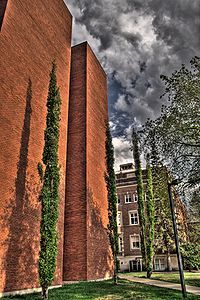
Winspear Business Reference Library
The library system comprises the following libraries:
- Augustana Faculty Library
- Bibliothèque Saint-Jean
- Book and Record Depository (BARD)
- Cameron Library (Science & Technology)
- H.T. Coutts Library (Education & Physical Education)
- J.A. Weir Memorial Law Library
- J.W. Scott Health Sciences Library
- Dr. Josephine M. Mitchell Mathematics Library
- Rutherford Library (Humanities & Social Sciences)
- Bruce Peel Special Collections Library
- Data Library
- Music Listening and Reserve
- Winspear Business Reference Library
School of Library and Information Studies
The university is also home to a School of Library and Information Studies. Notably the school offers a Master of Library and Information Studies (MLIS) degree, accredited by the American Library Association, and is hosted in Rutherford South, the original four story brick, marble, and oak main campus library, opened in 1951.
Research overview
Housing over 400 distinct research laboratories, the University of Alberta is one of the leading research universities in Canada. The university is a member of the G13 universities, which are the leading research universities in Canada. In the period from 1988 to 2006, the University of Alberta received about $3.4B for research from external sources, with $404M in 2005-2006 alone. The University of Alberta is consistently ranked among the top research universities in Canada.
Notably the University of Alberta is also the national scientific and administrative headquarters for:
- Sustainable Forest Management
- Network of Centres of Excellence
- Prairie Centres of Excellence
- Canadian Obesity Network
Medical research
Medical researchers are developing the Edmonton Protocol, which is a new treatment for type one diabetes that enables diabetics to break their insulin dependence. The project was originally developed by Drs. James Shapiro, Jonathan Lakey, and Edmond Ryan. The first patient was treated in 1999. As of 2006, the project is developed through the Clinical Islet Transplant Program.
Population research
- Population Research Laboratory
Biomedical research
Biomedical researchers, headed up by Michael Ellison have initiated a project to model Eukaryotic cells in detail, called Project Cybercell.
Nanotechnology research
In June 2006, a new 120 million dollar building for the National Institute for Nanotechnology (NINT) was opened on campus. The NINT complex is one of the world’s most technologically advanced research facilities, housing the quietest, and cleanest, laboratory space in Canada. NINT occupies five floors of the new building with the top two floors being reserved by the university for nanotechnology-related research. Recently some staff members have been jointly recruited by the NRC and the University of Alberta.
Other
- The university participated in the initial development of the Mizar system
- The asteroid 99906 Uofalberta is named in the university's honour, in part because the initials of its motto Quaecumque Vera ("Whatsoever things are true") appeared in the object's provisional designation 2002 QV53.
Services for Aboriginal people
The University of Alberta provides services to Aboriginal people in more remote communities. University of Alberta provides special first-year bridging programs for Aboriginal students. The University of Alberta’s Aboriginal Teacher Education Program at Blue Quills First Nations College was developed in partnership with specific Aboriginal communities to meet specific needs within Aboriginal communities. The Faculty of Native Studies at University of Alberta was designed to meet the knowledge needs of First Nations, Métis and Inuit. The University of Alberta reaches into Aboriginal communities to talk to potential students at a much younger age through its Summer Science Camps for Aboriginal high school students.
Reputation
| University rankings |
| ARWU World |
101-151 |
| ARWU N. America |
60-77 |
| ARWU Engineering & CS |
78-107 |
| ARWU Life Sciences |
76-107 |
| ARWU Clinical Medicine |
77-107 |
| Newsweek World |
55 |
| THE-QS World |
59 |
| THE-QS Arts |
101 |
| THE-QS Life Sciences/Biomed |
52 |
| THE-QS Natural Sciences |
75 |
| THE-QS Engineering/Tech. |
46 |
| Canadian rankings |
| Maclean's Medical/Doctoral |
5 |
|
v • d • e
|
The University of Alberta consistently ranks as one of the top universities in Canada. Historically the university has produced 65 Rhodes Scholars and 1 nobel laureate.
Top 5 overall
Newsweek
Newsweek (International Edition) in 2006 rates the top 5 Canadian universities (world rankings in brackets):
1) University of Toronto (18)
2) University of British Columbia (31)
3) McGill University (42)
4) University of Alberta (55)
5) University of Waterloo (84)
THES-QS
The Times Higher Education Supplement in 2009 rates the top 5 Canadian universities (world rankings in brackets):
1) McGill University (18)
2) University of Toronto (29)
3) University of British Columbia (40)
4) University of Alberta (59)
5) Université de Montréal (107)
Webometrics
Webometrics Ranking of World Universities in 2008 rates the top 5 Canadian universities (world rankings in brackets):
1) University of Toronto (28)
2) University of British Columbia (49)
3) University of Calgary (50)
4) University of Alberta (59)
5) Simon Fraser University (69)
Research Based Ranking
Research Infosource in 2008 and 2009 ranks the top 5 Canadian universities by research criteria:
1) University of Toronto
2) University of Alberta
3) University of British Columbia
4) Université de Montréal
5) McGill University
Discipline specific rankings
The University of Alberta is consistently highly placed in national and worldwide rankings for its engineering and technology, sciences, lifesciences and medicine programs.
Engineering and technology
The Times Higher Education Supplement in 2009 rated the University of Alberta within the top 5 Canadian and top 50 worldwide universities for technology (world rankings in brackets):
1) University of Toronto (8)
2) University of British Columbia (17)
3) McGill University (20)
4) University of Waterloo (27)
5) University of Alberta (46)
Lifesciences and medicine
The Times Higher Education Supplement in 2009 rated the University of Alberta within the top 5 Canadian and top 50 worldwide universities for lifesciences and biomedicine (world rankings in brackets):
1) University of Alberta (10)
2) University of Toronto (11)
3) University of British Columbia (16)
4) University of Alberta (52)
5) McMaster University (60)
In its 2008 survey, Maclean’s, a leading Canadian news magazine, rates the University of Alberta 5th in the Medical-Doctoral category by National Reputational Ranking.
The top five in this category were:
1) McGill University
2) University of Toronto
3) Queen's University
4) University of British Columbia
5) University of Alberta
Beginning in 2006, The University of Alberta (along with 22 other universities) has declined to participate in the Maclean's annual university rankings issue, due to concerns that past rankings have been inaccurate.
Natural sciences
The Times Higher Education Supplement in 2009 rated the University of Alberta within the top 5 Canadian universities for natural sciences (world rankings in brackets):
1) University of Alberta (75)
2) University of British Columbia (20)
3) McGill University (26)
4) University of Waterloo (56)
5) University of Toronto (14)
Employment Based Ranking
In October 2008, the University of Alberta was named one of "Canada's Top 100 Employers" by Mediacorp Canada Inc., and was featured in Maclean's newsmagazine. Later that month, the university was also named one of Alberta's Top Employers, which was announced by the Calgary Herald and the Edmonton Journal.
University Report Card
The Globe and Mail's University Report Card reflects the opinions of 32,700 current undergraduates who responded to some 100 questions about their respective universities. The University of Alberta received high (A- and above) grades in the following categories:
- overall academic reputation of the university, reputation of university among employers, reputation for conducting leading-edge research, reputation for undergraduate studies, reputation for graduate studies
- overall quality of education, faculty members' knowledge of subjects
- overall university atmosphere, sense of personal safety/security, tolerance for diverse opinions/ideas, availability of quiet study space, overall library, library services, online library resources, availability of journals/articles/periodicals, total number of library holdings, computer accessibility on campus, availability of up-to-date computer equipment, on-campus network for Internet/email, overall quality/availability of technology on campus, access to course/teaching materials online
Campuses
The university has several distributed campus facilities including, other than the Main Campus, two auxiliary satellites; Campus Saint-Jean in east Edmonton, and Augustana Campus in Camrose. An extensively renovated and refurbished Hudson's Bay department store in downtown Edmonton, renamed Enterprise Square, serves as a campus for adult students belonging to the Faculty of Extension. Notably the university owns a set of large parcels of undeveloped land (currently used as an experimental farm) slightly south of the main campus, called South Campus, in which an entire new university complex will gradually be constructed of similar magnitude to the Main Campus.
North 校园
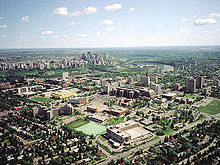
University, river valley, and downtown Edmonton
Also known as Main Campus, the North Campus is the original location of the University of Alberta. It is located on the southern banks of the North Saskatchewan River. It has 145 buildings on 92 hectares of land. It is at colatitude equator's reciprocal, meaning that its colatitude (angle from the north pole) is the reciprocal or multiplicative inverse of the equator's angle of π/2 from the north pole (in radians), so it is at colatitude 2/π radians, or about 36.4756 degrees from the north pole, at latitude π/2-2/π radians or 53°31′28″ north of the equator. Also coincidentally, the longitude is very precisely 60 degrees greater than the latitude, so it is at 5π/6-2/π radians or 113°31′28″ west longitude.
A satellite view of the main campus can be seen on Google maps.
Architect Barton Myers completed the long-range campus plan in 1969 and continued as a planner for the University until 1978.
Campus Saint-Jean
The Campus Saint-Jean is a francophone campus located 5 km east of the main campus, in Bonnie Doon. It is the only French-language university campus west of Manitoba. Due to increasing enrolment, the Campus Saint-Jean is currently undergoing expansion, acquiring new laboratory and classroom spaces. Students at Campus Saint-Jean currently may pursue Bachelor's degrees in the sciences or arts, or complete their first year of Engineering, after which they often transfer to the University of Alberta's main campus.
Augustana 校园
The Augustana Campus is located in Camrose, a small city in rural Alberta about 100 km southeast of Edmonton. In 2004, the former Augustana University College in Camrose merged with the University of Alberta, thus creating the new satellite Augustana Campus. Students enrolled at the Augustana Campus currently may pursue four-year Bachelor's degrees in arts, sciences, or music.
Enterprise Square
Enterprise Square opened for business January 15, 2008 on the north side of the North Saskatchewan river in downtown Edmonton. It is located in the historical building previously occupied by the Hudson's Bay Company. The building underwent major renovations. Currently, Enterprise Square houses the Faculty of Extension, the professional development activities of the School of Business, the Alberta Business Family Institute, and the Design Gallery. It is also the new home of the University of Alberta Alumni Association.
Future campuses
The University of Alberta has future plans for one more Edmonton campus. The South Campus is much larger in terms of land area and located two kilometres to the south of the Main Campus, with a convenient high speed link via Light Rail Transit. The transit station is near Foote Field and Saville Sports Centre, forming a natural gateway to the new campus architectural model. Since South Campus LRT opened in April 2009, the U of A became the only university in Canada with four LRT/Subway stations on its campuses (Along with University, Health Sciences/Jubilee, and Bay/Enterprise Square stations). Preliminary long range development thinking for South Campus implies it may become an expanding academic and research extension of the Main Campus, with rapid development over the next few decades. New architectural guidelines, differing from the Main Campus might encourage a somewhat more consistent, high quality, aesthetic architectural style. As there is a large expanse of land available, significant green space will be incorporated to provide a park like context overall.
Recent Developments and Investment in Health and Science
$1.6 Billion dollars in construction is underway at the University in regards to fields in Health and Science. Most projects will be complete in 2011 and is expect to greatly expand the University of Alberta's research capacity in the field of Health in particular. Currently the University of Alberta attracts approximately $500 million in external research funding a year, the second highest in Canada, and is expected to increase due to added state-of-the-art research and teaching capacity.
Centre for Interdisciplinary Science
One of the major projects underway is the construction of a new $400 million state-of-the-art facility, scheduled for completion in January 2011 and to be known as the Centennial Centre for Interdisciplinary Science (CCIS), a facility for interdisciplinary research groups, as well as the Department of Physics. Three buildings - V-Wing (a large one-floor building composed of 10 lecture halls, of which two will remain), the Avadh Bhatia Physics Building (a six-storey building formerly housing the Department of Physics offices and laboratories), and the old Centre for Subatomic Research - have been demolished to make way for CCIS. Many of the classes and labs that were held in these buildings have now been relocated to other new or recently renovated buildings, such as the building now known as the Civil Electrical Building (CEB), which currently holds the Department of Physics offices, undergraduate labs, and classrooms, plus the first phase of the CCIS facilities which presently house the Condensed Matter labs.
The Edmonton Clinic
Construction on two new buildings totalling $909 million 170,000 Sq.M multidisciplinary health science facility, surrounding the new Health Science LRT Station, started in early 2008. The Edmonton Clinic North being built by the University of Alberta is slated for completion in 2011. The Edmonton Clinic South being built by Alberta Health Services is slated for completion in 2012. The Edmonton Clinic (formerly the Health Science Ambulatory Learning Centre) is a joint project with Alberta Health Services, and consists of two separate buildings. Edmonton Clinic South, a 9 story building, will focus on patient care and house most of the medical and dental clinics, while Edmonton Clinic North is a 6 story building that will focus on research and education currently held at the university.
Health Research Innovation Facility (HRIF)
Two new $300 million buildings adjacent to the Heritage Medical Research Centre building on the main campus will contribute to research by allowing the university to hire over 100 additional biomedical and health researchers, this is projected to result in a doubling of research funding by 2014.
Health Research Innovation Facility (HRIF) is a translational research centre designed to create an environment for innovative "bench-to-bedside" health research by increasing interaction between researchers and clinicians focused on common medical issues.A total of 65,000 square meters gross area constructed on two sites.
HRIF West
The hub of the complex is HRIF West, an 8-story building which provides the main entrance to the complex and becomes the critical link between MSB and HMRC. The atrium connection between MSB and HRIF West provides an impressive public venue for the entire facility. The large Lecture Theatre, Teaching and Learning Centre and food service kiosks are located with the atrium which also supports interaction between researchers as well as important links to the existing circulation systems.
HRIF East
HRIF East provides access to the complex from the south and east as well as to the Alberta Diabetes Research Institute ("ADRI") which will occupy several floors within this 9-stoery building. Both the east and west buildings of HRIF are linked at every floor to HMRC with the exception of Level 1 of HRIF West. HRIF West is linked to MSB through the atrium and bridge connections at several levels. In addition HRIF East connects directly to NANUC as well as the new parkade to the south. Completing the complex, the Zeidler (GI) Building and Clinical Training Centre ("CTC") is also connected to the parkade and directly linked to Walter C. Mackenzie Health Sciences Centre ("WCMHSC"). A Bio-Hazard Level 3 laboratory is located in the basement of the east building, one of the largest one in Canada at over 5,000 square feet over nine stories.
Student life and Residences
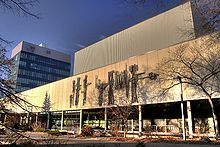
South side of the Students' Union Building.
Student Bodies
See also: University of Alberta Students' Union
In 1946 the university student council met to consider possible blueprints for a new building, including a large auditorium, during a time when veterans were returning to complete their interrupted studies. The new building was financed by a series of mechanisms, and the completed structure, after a series of additions, now with the large auditorium, named after Myer Horowitz, opened in 1967.
The Students' Union Building (SUB) has been expanded twice since its original construction. It holds a number of services and businesses owned and operated by the Students' Union as well as services owned and operated by the University of Alberta, including the University Bookstore.
Undergraduate and graduate students' organizations are registered with the Students Union (SU) and Graduate Students Association (GSA) of the university.
Residences
The University of Alberta offers a wide range of residences on its campuses.
While a majority of the university's students live off-campus, a significant number of students from outside Edmonton in early years of their post secondary education opt to live in residences operated by the university's Residence Services.
- Lister Centre is a large residence complex, located in four towers, mainly occupied by first and second year students. It provides a full care boarding package, with hospitality programs to help integrate new students into university life. The complex offers a large number of furnished single and double dormitory style rooms with common kitchens and living areas. There is a large scale cafeteria, in the central building of the complex. It is the largest residence on campus with a population of 1800.
- HUB International houses a combination of international students and Canadians with a selection of very high quality bachelor suites and also single, double and quadruple bedroom apartments. The 957-foot long design, by architect Barton Myers, became a prototype for cold Canadian climates. It is the second largest residence on campus with a population of 850. The official student group for HUB Residents is the HUB Community Association (HCA)
- International House is a new residence designed for international students and a few Canadian students, interested in living with international students. It offers modern well equipped single bedrooms with common kitchens and living spaces, both furnished and unfurnished.
- Newton Place is a high rise offering older students an apartment-style facility.
- East Campus Village comprises houses and walk-up townhouses, offering older and married students a modern multi-room facility.
- Michener Park. Offers older students another apartment-style facility.
- St. Joseph's College Residence operates an all-male residence, independent of the university's official residence service.
- La Résidence Saint-Jean operates a modern apartment style, French language oriented, residence on Campus Saint-Jean, about six kilometers east of the Main Campus.
- Augustana Faculty Residences comprise two distinct compounds. The 300-room First Year residence complex is similar in style to, although much smaller than, Lister Centre, and is comprised entirely of double rooms. Across a small ravine from the rest of the campus there is another compound of seven smaller buildings (six residences and a common area) known collectively as the "Ravine Complex" that house almost exclusively upperclassmen. The Augustana Faculty is the only faculty in the University with a residence requirement whereby, with certain exceptions, all students are expected to spend their first year in residence on campus.
体育运动
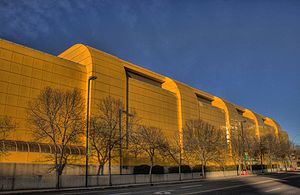
South side of the Butterdome sports complex (officially called the Universiade Pavilion).
The University of Alberta is represented in Canadian Interuniversity Sport by the Alberta Golden Bears (men's) and the Alberta Pandas (women's). The Green & Gold Soccer Club is the university's soccer centre..
Alberta Pandas
As of November 2006, the Panda's hockey team has won the Canada West Conference 7 times in the 8 year history of competition. In addition, they have claimed the national championship five times in the last seven years, in 2006, 2004, 2003, 2002, and 2000. They also boast a pair of silver medals (2005, 1999) since the inception of the CIS championship in 1997-98. When the Pandas lost the CIS championship game in March 2005, it ended a 110-game undefeated streak (109-0-1).
The Pandas volleyball team are frequent national contenders. They last claimed the national championship after beating Laval University 3-1 in March 2007. They previously won 6 national titles in a row beginning in the mid 1990s.
Past University of Alberta student, Trevor Reitsma, is currently training with the Canadian 2010 olympic team in Lake Louise.
Alberta Golden Bears
Main article: Alberta Golden Bears
The Golden Bears hockey team has played in the CIS University Cup finals, winning an unprecedented 13 times. Every fall the team plays against the Edmonton Oilers rookies. In 2006 they lost 6-3, ending their five game winning streak against the rookies.
Green & Gold Soccer Academy
The soccer team of the Golden Bears played as Green & Gold Soccer Academy and L'Academie Vimy Ridge Academy.
Proposals for Enhanced Facilities
Physical Activity and Wellness (PAW) Centre
The $65 million project has been approved by the student body and is in the final stages of approval. The University of Alberta is proposing to develop a new 2000 m2 (20 000 ft2) Fitness Centre and state-of-the-art climbing complex as a part of the proposed overall Physical Activity and Wellness (PAW) Centre. The PAW Centre would include the integration the Fitness and Lifestyle Centre/Climbing Complex at the corner of 87 Avenue and 114 Street.
The PAW Centre will enhance student experience by providing: A new indoor atrium student lifestyle centre called the “social street,” which is created by enclosing the existing outdoor space between the main gymnasium, Universiade Pavilion and the Van Vliet Centre – East Wing; Additional student-focused multi-purpose space, including food retail, quiet study space, a games room, lounges, and prayer/meditation space; Fitness component includes individual and group training space, free weights, machine weights, stretching areas, cardio and fitness equipment, and locker room renovations; combine new construction with interior renovations of existing buildings.
[edit] Cheer Song
Notable among a number of songs commonly played and sung at various events such as commencement, convocation, and athletic games are: 'University of Alberta cheer song' with words by R.K. Michael and music by Chester Lambertson; 'The Evergreen and Gold' (1915) with words by William H. Alexander and sung to the Russia national anthem; and 'Quaecumque vera,' with words and music by Ewart W. Stutchbury.
Distinguished University of Alberta people
Current faculty
- Jonathan Schaeffer, computer scientist and the Canada Research Chair in Artificial Intelligence.
- Edward D. Blodgett, author and researcher in comparative literature, religion and film/media.
- Jacob Masliyah, pioneer researcher in oilsands extraction, recipient Order of Canada.
- Jonathan Locke Hart, author, literary scholar and historian.
- Greg Hollingshead, Canadian novelist and professor of English
- Adam Morton, philosopher and member of the Royal Society of Canada
- James Shapiro, medical researcher
- Ali A. Abdi - anthropologist and author.
- Mark Lewis, mathematical ecologist and the Canada Research Chair in Mathematical Biology at the Centre for Mathematical Biology.
Past faculty
- William Hardy Alexander, one of the university's first four professors and university historian
- Margaret Atwood, author.
- John B. Dossetor, Professor Emeritus of Medicine and Bioethics
- Henry Marshall Tory, first president, founder of three universities, the Alberta Research Council and National Research Council of Canada
Alumni
学术
- Sir John Bell - Regius Chair of Medicine, University of Oxford
- Bernadette Louise Dean - Principal of Kinnaird College, Pakistan
- Bas van Fraassen - Princeton University, McCosh Professor of Philosophy
- Su Guaning - President of Nanyang Technological University
- Raymond U. Lemieux - Chemistry pioneer, winner of the Wolf Prize in Chemistry (1999) and the Albert Einstein World Award of Science (1992)
- Tak Wah Mak - Molecular biologist
- Joseph B. Martin - Dean of Harvard Medical School
- Janice Stein - International relations researcher
- Richard E. Taylor - Nobel Laureate
- Wallace Sterling - Past president of Stanford University
Authors
- Todd Babiak
- Nathan Braun
- Aritha Van Herk
- Arthur Kroeger
- Robert Kroetsch
- W.O. Mitchell
- Candace Savage
- Timothy Taylor
- Vern Thiessen
- Rudy Wiebe
- Brian Tracy
Politicians
- Rona Ambrose - Minister of Intergovernmental Affairs
- Pat Binns - Former Premier of Prince Edward Island
- Joe Clark - Former Prime Minister of Canada
- Charles Dent - Former NWT Cabinet Minister
- David Emerson - Minister of International Trade
- Lou Hyndman - Former Alberta cabinet minister
- J. Wilton Littlechild - Former Member of parliament
- Peter Lougheed - Former Premier of Alberta
- Preston Manning - Former leader of the Reform Party of Canada, and founder of two Canadian political parties
- Beverley McLachlin - Chief Justice of Canada
- Roland Michener - Former Governor General
- David Hancock - Minister of Education of Alberta
- Jim Prentice - Minister of Environment
- Ed Stelmach - Current Premier of Alberta (Attended, did not graduate)
- Jane Sterk - Leader of the Green Party of British Columbia
- Allan Wachowich - Current Chief Justice of the Court of Queen's Bench of Alberta
Other notable alumni
- Doris Anderson - Editor and rights activist
- Clarence Campbell - Hockey legend
- Neil Campbell - Discovered gold in Yellowknife
- Ted Corday - Soap opera creator (Days of our Lives)
- Jim Coutts - Political advisor
- Randy Gregg - Former National Hockey League player and medical researcher
- Paul Gross - Actor
- Jan Randall - Composer and Musician
- Daryl Katz - Billionaire entrepreneur, owner of the Rexall Pharmacy chain and the Edmonton Oilers
- George Stanley - Designer of the Canadian flag
- Ivan Head - Former policy adviser of Prime Minister Pierre Trudeau
- Robert Steadward - Former International Paralympic Committee President
- Anne Wheeler - Film director
- Nathan Fillion - Actor
- Dayo Wong - Hong Kong Actor, Comedian, Singer and Screen Writer
Rhodes Scholars
To date the U of A has produced 67 Rhodes scholars. A few of them are:
- Roland Michener 1919, 20th Governor General of Canada
- George Stanley 1929, Designed the Canadian flag
- Arthur Kroeger 1956
Honorary degree recipients
See also: List of University of Alberta honorary degree recipients
- Douglas Cardinal - Canadian architect
- Victor Cavendish - Former Governor General of Canada
- Jean Chrétien - former Prime Minister of Canada
- John Diefenbaker - former Prime Minister of Canada
- Wayne Gretzky - former National Hockey League player
- Frederick Haultain - the first and only premier of Canada's North-West Territories
- Horace Harvey - The second Chief Justice of Alberta, and chairman of the University of Alberta Board of Governors
- Lois Hole - former Lieutenant Governor of Alberta
- Ernest Manning - former Premier of Alberta
- Don Mazankowski - former Deputy Prime Minister of Canada
- Walter Murray - first President of the University of Saskatchewan
- Alexander Rutherford - first Premier of Alberta
- Arthur Sifton - former Premier of Alberta
- Manmohan Singh - Prime Minister of India
- Donald Smith - 1 Baron Strathcona and Mount Royal
- Harry Strom - former Premier of Alberta
- Mother Teresa - missionary
- Pierre Trudeau - former Prime Minister of Canada
- Desmond Tutu - former Archbishop of Cape Town and current chair of the Global Elders
- His Highness the Aga Khan - Spiritual Leader of the Ismaili Muslims
- Max Ward - pioneering Canadian aviator
- Charles, Prince of Wales
- King Edward VIII
Histories of the university
- Maureen Aytenfisu. "The University of Alberta: Objectives, Structures, and Role, 1908-1928." M.A. thesis, University of Alberta, 1982.
- Johns, Walter H. A History of the University of Alberta, 1908-1969. Edmonton: University of Alberta Press, 1981.
- William Hardy Alexander, The University of Alberta: A Retrospect 1908-1929
- Walter Johns [3], History of the University of Alberta
- John Macdonald, The history of the University of Alberta, 1908-1958
- Rod McLeod, History of the University of Alberta 1908-2008 (work in progress)
- Scott Rollans 'Echoes in the Halls: An Unofficial History of the University of Alberta' (Association of Professors Emeriti of the U of A, University Of Alberta, November 1, 1999)
- Ellen Schoeck, I Was There: A Century of Alumni Stories about the University of Alberta, 1906–2006
更多
 |
Wikimedia Commons has media related to: University of Alberta |
 |
University of the Arctic portal |
- Faculties and departments of the University of Alberta
- Presidents of the University of Alberta
- Chancellors of the University of Alberta
- List of agricultural universities and colleges
- List of universities in the Canadian Prairies
- Higher education in Alberta
- Canadian Interuniversity Sport
- Canadian government scientific research organizations
- Canadian university scientific research organizations
- Canadian industrial research and development organizations
- Folkways Records
参考文献
- ^ "U.S. and Canadian Institutions Listed by Fiscal Year Endowment Market Value and Pecentage Change in Market Value from FY 2008 to FY 2009". NACUBO. 2010. http://www.nacubo.org/Documents/research/2009_NCSE_Public_Tables_Endowment_Market_Values.pdf.
- ^ "University of Alberta Staff Summary Table as of April 2008". University of Alberta. 2007. http://www.ualberta.ca/~idosa/databook/07-08/data_files/DB410708.pdf. Retrieved 2009-01-27.
- ^ "University of Alberta Summary of Statistics - Academic Year 2008/2009: Spring, Summer, Fall and Winter Terms". University of Alberta. 2009. http://www.registrar.ualberta.ca/sosfiles/Winter-2009/Tabl01w.pdf. Retrieved 2010-03-03.
- ^ "A Gentleman of Strathcona - Alexander Cameron Rutherford", Douglas R. Babcock, 1989, The University of Calgary Press, 2500 University Drive NW, Calgary, Alberta, Canada, ISBN 0-919813-65-8
- ^ "Henry Marshall Tory, A Biography", originally published 1954, current edition January 1992, E.A. Corbett, Toronto: Ryerson Press, ISBN 0-88864-250-4
- ^ http://www.qp.alberta.ca/574.cfm?page=p19p5.cfm&leg_type=Acts&isbncln=9780779737932 Post-secondary Learning Act
- ^ "Record energy revenues boost province's surplus". Government of Alberta. 2005. http://www.gov.ab.ca/acn/200511/1907299D61F81-DEC8-EA80-06936D6F35D8786C.html. Retrieved 2006-11-20.
- ^ "Bill 1 to secure Albertans' access to the future". Government of Alberta. 2005. http://www.advancededucation.gov.ab.ca/news/2005/March/nr-Bill1.asp. Retrieved 2006-11-20.
- ^ "University". The Canadian Encyclopedia. http://www.thecanadianencyclopedia.com/index.cfm?PgNm=TCE&Params=A1ARTA0008242. Retrieved 2009-10-20.
- ^ "The University of Alberta". The Canadian Encyclopedia. http://www.thecanadianencyclopedia.com/index.cfm?PgNm=TCE&Params=U1ARTU0003521. Retrieved 2009-10-20.
- ^ Tory to Rutherford, March 6, 1906. University of Alberta Archives (UAA), Rutherford Fonds, 2/3/6-8
- ^ "University Act, 1910". University of Alberta. http://www.ualbertacentennial.ca/history/founding/university_act.html. Retrieved 2009-10-20.
- ^ Bilash, O.S.E. and O.F.G. Sitwell. Words Into Buildings: The University of Alberta, 1906-28. Mar. 1995 (20:1), p. 4-21.
- ^ "History of Medical Education in Canada". The Canadian Encyclopedia. http://www.thecanadianencyclopedia.com. Retrieved 2009-10-20.
- ^ Dominion Bureau of Statistics, Canada Year Book 1921, Ottawa, 1922
- ^ "Folio". Home page. University of Alberta. http://www.ualberta.ca/folio/. Retrieved October 20, 2009.
- ^ "The Gateway Online". http://www.thegatewayonline.ca. Retrieved October 20, 2009.
- ^ "The Gold Standard". Home Page. http://www.goldstandardnation.ca. Retrieved October 20, 2009.
- ^ "Student Newspaper". The University of Alberta Augustana Campus. http://www.augustana.ca/sa/services/newspaper.html. Retrieved October 20, 2009.
- ^ "University Presses". The Canadian Encyclopedia. http://www.thecanadianencyclopedia.com/index.cfm?PgNm=TCE&Params=A1ARTA0008267. Retrieved 2009-10-20.
- ^ The University of Alberta Press
- ^ "University of Alberta Facts: International Links". University of Alberta. 2010. http://www.uofaweb.ualberta.ca/facts/nav01.cfm?nav01=16131. Retrieved 2010-03-03.
- ^ "University of Alberta Facts: Teaching Excellence". University of Alberta. 2006. http://www.uofaweb.ualberta.ca/facts/nav01.cfm?nav01=16136. Retrieved 2006-11-19.
- ^ "Profs earn perfect grades in teaching". University of Alberta ExpressNews. 2007. http://www.expressnews.ualberta.ca/print.cfm?id=8310. Retrieved 2007-05-17.
- ^ University of Alberta. "Peter Gill". http://www.ualberta.ca/SIGNATURE/ke_gill.html. Retrieved 2009-10-20.
- ^ http://tools.canlearn.ca/
- ^ Canadian Engineering Memorial Foundation - University List
- ^ "Faculty of Physical Education and Recreation". University of Alberta. http://www.physedandrec.ualberta.ca/. Retrieved 2009-10-20.
- ^ "Faculty of Physical Education and Recreation: Undergraduate Programs". University of Alberta. http://www.physedandrec.ualberta.ca/undergraduate.cfm. Retrieved 2009-10-20.
- ^ "ARL Statistics". Association of Research Libraries. 2004. http://fisher.lib.virginia.edu/cgi-local/arlbin/arl.cgi?task=setupsubset. Retrieved 2006-11-24.
- ^ "University of Alberta Facts: Facilities". University of Alberta. 2006. http://www.uofaweb.ualberta.ca/facts/nav01.cfm?nav01=16132. Retrieved 2006-11-19.
- ^ "Mission Statement". School of Library and Information Studies. 2000. http://www.slis.ualberta.ca/missionstatement.htm. Retrieved 2006-11-21.
- ^ "List of Institutions with ALA-Accredited Programs". American Library Association. 2006. http://www.ala.org/ala/accreditation/lisdirb/Alphaaccred.htm. Retrieved 2006-11-21.
- ^ "University of Alberta Facts: Transformative Research". The University of Alberta. 2006. http://www.uofaweb.ualberta.ca/facts/nav01.cfm?nav01=16139. Retrieved 2006-12-08.
- ^ "Top 3000 Universities". Webometrics Ranking of World Universities. 2007. http://www.webometrics.info/top3000.asp. Retrieved 2007-06-07.
- ^ "The Top 100 Global Universities". Newsweek. 2006. http://www.msnbc.msn.com/id/14321230/. Retrieved 2006-08-28.
- ^ "World University Rankings". The Times Higher Education Supplement. 2005. http://www.alnaja7.org/success/Education/times_world_ranking_2005.pdf. Retrieved 2006-08-28.
- ^ "Annual University Rankings". Maclean's. 2005. http://www.uofaweb.ualberta.ca/strategic/nav01.cfm?nav01=17118. Retrieved 2006-08-28.
- ^ "New treatment for diabetes major step forward in the fight against the disease". The University of Alberta's Faculty of Medicine & Dentistry. 2000. http://www.med.ualberta.ca/news-publications/article.cfm?id=20. Retrieved 2006-12-08.
- ^ "Flagship Nanotechnology Institute's New Home Features Canada's Quietest Space". The National Research Council of Canada. 2006. http://www.nrc-cnrc.gc.ca/newsroom/news/2006/nint06-nr_e.html. Retrieved 2006-12-08.
- ^ "Jet Propulsion Laboratory Small-Body Database: 99906 Uofalberta (2002 QV53)". NASA. 2002. http://ssd.jpl.nasa.gov/sbdb.cgi?sstr=99906;orb=0;cov=0#discovery. Retrieved 2006-11-22.
- ^ The University of Winnipeg
- ^ "Academic Ranking of World Universities". Institute of Higher Education, Shanghai Jiao Tong University. 2008. http://www.arwu.org/rank2008/EN2008.htm. Retrieved 2009-01-04.
- ^ "Top 100 North & Latin American Universities". Institute of Higher Education, Shanghai Jiao Tong University. 2008. http://www.arwu.org/rank2008/ARWU2008_TopAmer(EN).htm. Retrieved 2009-01-04.
- ^ "Top 100 world universities in Engineering/Technology and Computer Sciences". Institute of Higher Education, Shanghai Jiao Tong University. 2008. http://ed.sjtu.edu.cn/ARWU-FIELD2008/ENG2008.htm. Retrieved 2008-02-19.
- ^ "Top 100 world universities in Life and Agriculture Sciences". Institute of Higher Education, Shanghai Jiao Tong University. 2008. http://ed.sjtu.edu.cn/ARWU-FIELD2008/LIFE2008.htm. Retrieved 2008-02-19.
- ^ "Top 100 world universities in Clinical Medicine and Pharmacy". Institute of Higher Education, Shanghai Jiao Tong University. 2008. http://ed.sjtu.edu.cn/ARWU-FIELD2008/MED2008.htm. Retrieved 2008-02-19.
- ^ "Top 100 Global Universities". Newsweek International. 2006. http://www.msnbc.msn.com/id/14321230/print/1/displaymode/1098/. Retrieved 2009-02-25.
- ^ "World University Rankings". Times Higher Education-Quacquarelli Symonds. 2008. http://www.timeshighereducation.co.uk/hybrid.asp?typeCode=243&pubCode=1&navcode=137. Retrieved 2008-12-31.
- ^ "THE-QS Top Universities Rankings: Arts and Humanities". Times Higher Education-Quacquarelli Symonds. 2008. http://www.topuniversities.com/worlduniversityrankings/results/2008/subject_rankings/arts_humanities/. Retrieved 2008-02-25.
- ^ "THE-QS Top Universities Rankings: Life Sciences and Biomedicine". Times Higher Education-Quacquarelli Symonds. 2008. http://www.topuniversities.com/worlduniversityrankings/results/2008/subject_rankings/life_sciences_biomedicine/. Retrieved 2008-02-25.
- ^ "THE-QS Top Universities Rankings: Natural Sciences". Times Higher Education-Quacquarelli Symonds. 2008. http://www.topuniversities.com/worlduniversityrankings/results/2008/subject_rankings/natural_sciences/. Retrieved 2008-02-25.
- ^ "THE-QS Top Universities Rankings: Technology". Times Higher Education-Quacquarelli Symonds. 2008. http://www.topuniversities.com/worlduniversityrankings/results/2008/subject_rankings/technology/. Retrieved 2008-02-25.
- ^ "Medical Doctoral Ranking". Maclean's. 2008. http://oncampus.macleans.ca/education/wp-content/uploads/2008/11/med.pdf. Retrieved 2009-01-04.
- ^ "The Complete List: The Top 100 Global Universities". Newsweek (International Edition). 2006. http://www.msnbc.msn.com/id/14321230/site/newsweek/. Retrieved 2006-11-19.
- ^ "THE - QS World University Rankings 2009 - top universities". Times Higher Education Supplement. 2009. http://www.topuniversities.com/university-rankings/world-university-rankings/2009/results. Retrieved 2009-10-11.
- ^ "Top 4000 Universities". Webometrics Ranking of World Universities. 2008. http://www.webometrics.info/top4000.asp. Retrieved 2008-08-27.
- ^ "Canada’s Top 50 Research Universities 2009". Re$earch Infosource. 2009. http://www.researchinfosource.com/media/2009Top50List.pdf. Retrieved 2009-11-07.
- ^ "THE - QS World University Rankings 2009 - Engineering/Technology". Times Higher Education Supplement. 2009. http://www.topuniversities.com/university-rankings/world-university-rankings/2009/subject-rankings/technology. Retrieved 2009-10-11.
- ^ "THE - QS World University Rankings 2009 - Life Sciences & Biomedicine". Times Higher Education Supplement. 2009. http://www.topuniversities.com/university-rankings/world-university-rankings/2009/subject-rankings/life-sciences-bio-medicine. Retrieved 2009-10-11.
- ^ http://oncampus.macleans.ca/education/wp-content/uploads/2008/11/med.pdf
- ^ "THE - QS World University Rankings 2009 - Natural Sciences". Times Higher Education Supplement. 2009. http://www.topuniversities.com/university-rankings/world-university-rankings/2009/subject-rankings/natural-sciences. Retrieved 2009-10-11.
- ^ "Calgary Herald, "Alberta’s top 40 places to work”, October 18, 2008". http://www.canada.com/calgaryherald/story.html?id=02b19397-2fdf-4039-ba29-b93eaf908adb.
- ^ "Edmonton Journal, "Alberta's best focus on attracting, keeping staff", October 31, 2008". http://www.canada.com/edmontonjournal/story.html?id=5bc8514a-b0eb-4538-bab4-a63f11f51a16.
- ^ "Reasons for Selection, 2009 Canada's Top 100 Employers Competition". http://www.eluta.ca/top-employer-university-of-alberta.
- ^ "University Report Card". The Globe and Mail. 2006. http://www.theglobeandmail.com/reportcard. Retrieved 2006-12-10.
- ^ "The Directory of Canadian Universities: University of Alberta". AUCC. 2006. http://www.aucc.ca/can_uni/our_universities/alberta_e.html. Retrieved 2006-12-10.
- ^ "University of Alberta officially opens Enterprise Square downtown campus". University of Alberta. 2008. http://www.expressnews.ualberta.ca/newsreleases.cfm?id=8997. Retrieved 2008-02-24.
- ^ Building on Vision - LRDP Brochure, 2001
- ^ [1]
- ^ "Top 100 Projects". Renew Canada. 2006. http://top100projects.ca/2009/centennial-centre-for-interdisciplinary-sciences-phase-2/. Retrieved 2009-12-22.
- ^ "CCIS - Construction Updates". University of Alberta Faculty of Science. 2006. http://www.science.ualberta.ca/CIS_updates.cfm. Retrieved 2006-12-27.
- ^ "Physics Move". University of Alberta Department of Physics. 2006. http://www.phys.ualberta.ca/move. Retrieved 2006-12-27.
- ^ Edmonton Clinic website
- ^ Health Research Innovation Facility 网址
- ^ "Residence Services". University of Alberta. http://www.uofaweb.ualberta.ca/residences/. Retrieved October 20, 2009.
- ^ "Lister Centre". University of Alberta Residence Services. http://www.uofaweb.ualberta.ca/residences/nav01.cfm?nav01=23116. Retrieved October 20, 2009.
- ^ "HUB". University of Alberta Residence Services. http://www.uofaweb.ualberta.ca/residences/nav01.cfm?nav01=23117. Retrieved October 20, 2009.
- ^ HCA Website "Hub Community Association". http://www.hcaonline.ca HCA Website. Retrieved October 20, 2009.
- ^ "International House". University of Alberta. http://www.uofaweb.ualberta.ca/ihouse/. Retrieved October 20, 2009.
- ^ "Newton Place". University of Alberta Residence Services. http://www.uofaweb.ualberta.ca/residences/nav01.cfm?nav01=23122. Retrieved October 20, 2009.
- ^ "East Campus Village". University of Alberta Residence Services. http://www.uofaweb.ualberta.ca/residences/nav01.cfm?nav01=23121. Retrieved October 20, 2009.
- ^ "Michener Park". University of Alberta Residence Services. http://www.uofaweb.ualberta.ca/residences/nav01.cfm?nav01=23123. Retrieved October 20, 2009.
- ^ "St. Joseph's College". University of Alberta. http://www.ualberta.ca/~stjoseph. Retrieved October 20, 2009.
- ^ "Residence Saint-Jean". University of Alberta Residence Services. http://www.uofaweb.ualberta.ca/residences/nav01.cfm?nav01=23542. Retrieved October 20, 2009.
- ^ "Residence Services". University of Alberta Augustana Campus. http://www.augustana.ca/student_life/reslife/. Retrieved October 20, 2009.
- ^ "Green & Gold facilitating player development in Edmonton". University of Alberta. http://www.uofaweb.ualberta.ca/greenandgoldsoccer/news.cfm?story=43115. Retrieved October 20, 2009.
- ^ "Faculty of Physical Education and Recreation - Pandas Hockey". http://www.bears.ualberta.ca/Hockey/Women. Retrieved October 20, 2009.
- ^ "Faculty of Physical Education and Recreation - Golden Bears Hockey". http://www.bears.ualberta.ca/Hockey/Men. Retrieved October 20, 2009.
- ^ Green and Gold Soccer Academy
- ^ College Songs and Songbooks
- ^ "Jonathan Schaeffer Home Page". University of Alberta. http://www.cs.ualberta.ca/~jonathan/. Retrieved October 20, 2009.
- ^ "UAP Books: Apostrophes IV". University of Alberta. http://www.uap.ualberta.ca/UAP.asp?lid=42&bookid=20. Retrieved October 20, 2009.
- ^ "Dr. Jacob Masliyah". Home Page. University of Alberta. http://www.ualberta.ca/~masliyah/. Retrieved October 20, 2009.
- ^ "Jonathan Hart". Macmillan. http://us.macmillan.com/author/jonathanhart. Retrieved October 20, 2009.
- ^ "Adam Morton, FRSC". University of Alberta. June 14, 2006. http://www.uofaweb.ualberta.ca/philosophy/news.cfm?story=47009. Retrieved October 20, 2009.
- ^ "Adam Morton". Home page. University of Alberta Faculty of Arts. http://www.uofaweb.ualberta.ca/philosophy/nav03.cfm?nav03=25363&nav02=12335&nav01=12326. Retrieved October 20, 2009.
- ^ "Mark Lewis Home Page". University of Alberta. http://www.math.ualberta.ca/~mlewis/people/mlewis.htm. Retrieved December 9, 2009.
- ^ "Event Details: William Hardy Alexander Award for Excellence in Sessional Teaching". University of Alberta. http://www.events.ualberta.ca/details.cfm?ID_event=2994. Retrieved October 20, 2009.
- ^ "Sir John Bell". Oxford Health Alliance. http://www.oxha.org/about/board-of-trustees/john-bell. Retrieved October 20, 2009.
- ^ "Dean of Harvard med school returns to his roots". University of Alberta. http://www.expressnews.ualberta.ca/article.cfm?id=3124. Retrieved October 20, 2009.
- ^ "Former chancellor Lou Hyndman receives an honorary degree". University of Alberta. http://www.uofaweb.ualberta.ca/expressnews_template/article.cfm?id=724. Retrieved October 20, 2009.
- ^ "Mr. Wilton Littlechild". UNPFII. http://www.un.org/esa/socdev/unpfii/en/member_littlechild.html. Retrieved October 20, 2009.
- ^ [http://www.ualberta.ca/~stdward/robert-steadward.htm "The Steadward Centre for Personal & Physical Achievement"]. The University of Alberta. http://www.ualberta.ca/~stdward/robert-steadward.htm. Retrieved 2009-10-20.
- ^ "Peter Gill". University of Alberta. 2009. http://www.ualberta.ca/SIGNATURE/ke_gill.html. Retrieved 2009-12-07.
- ^ "The University of Alberta: A Retrospect 1908-1929", William Hardy Alexander, Edmonton, University Printing Press, 1929
- ^ "History of the University of Alberta", Walter. H. Johns, The University of Alberta Press, 1981, ISBN 0-88864-025-0
- ^ "The history of the University of Alberta, 1908-1958", John MacDonald, University of Alberta, 1958, ASIN B0007EFODW
- ^ "I Was There: A Century of Alumni Stories about the University of Alberta, 1906–2006", Ellen Schoeck, Foreword Jim Edwards, The University of Alberta Press, 2006, ISBN 0-88864-464-7
External links
- University of Alberta
- University of Alberta



